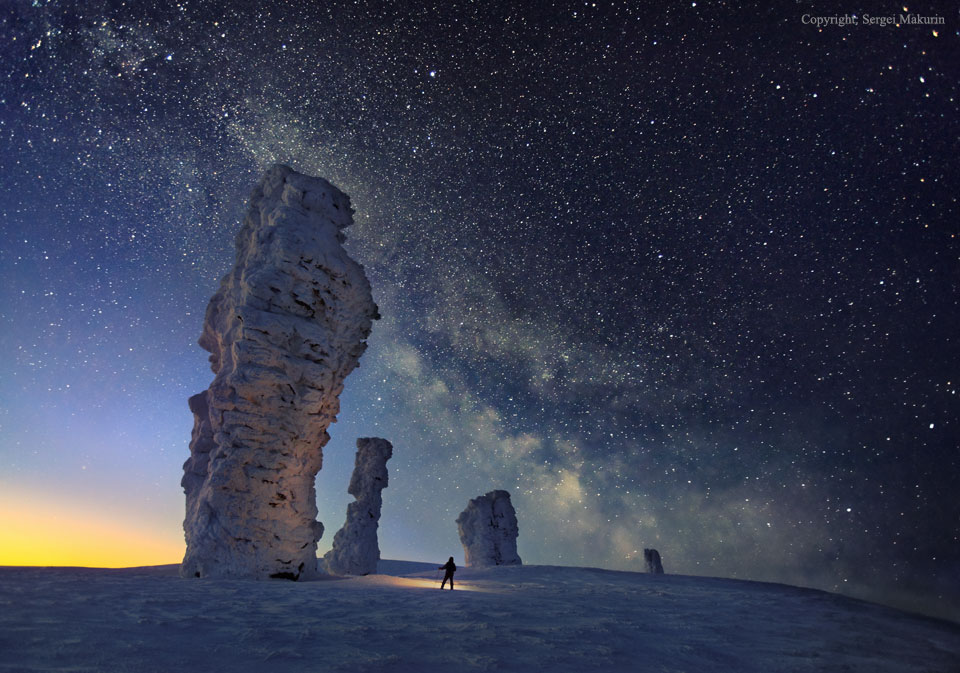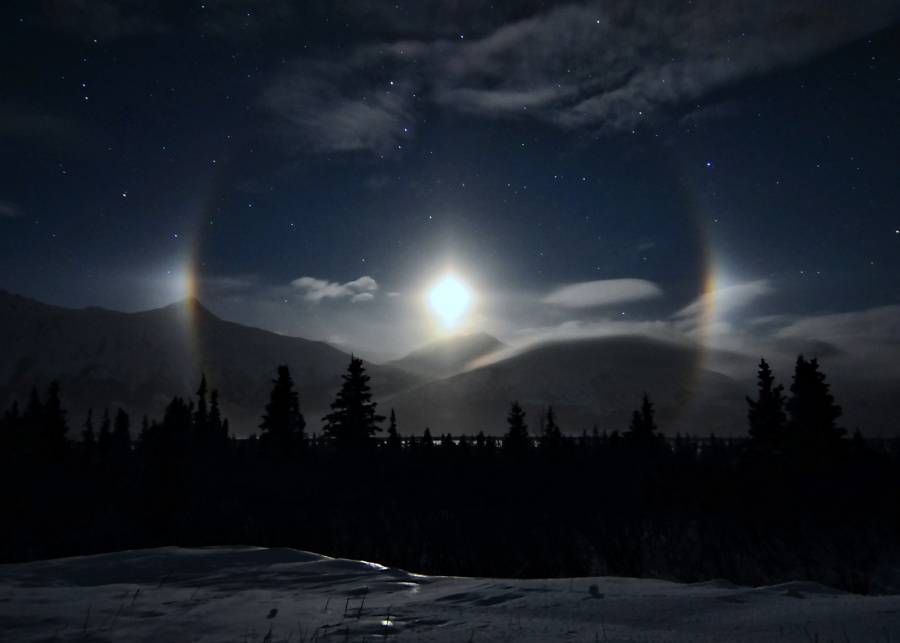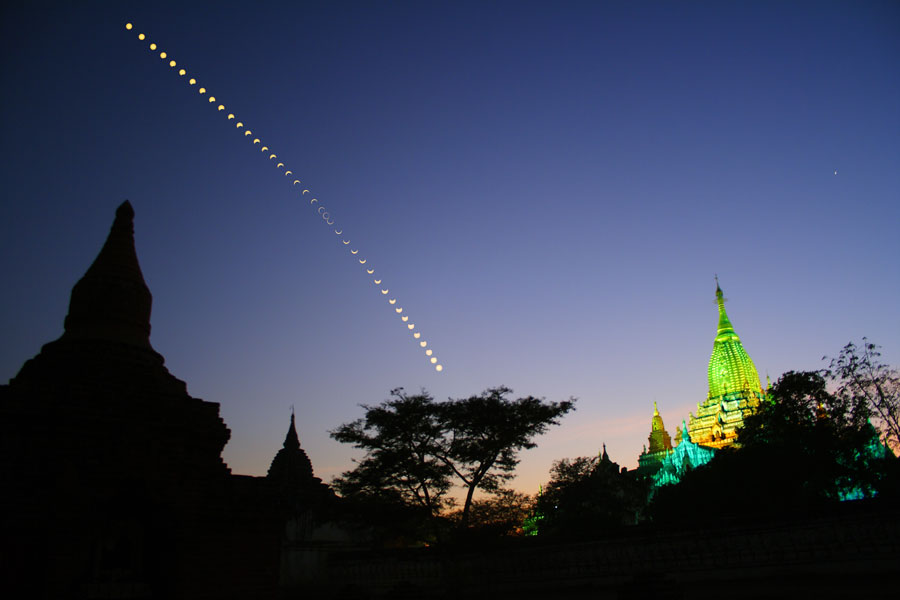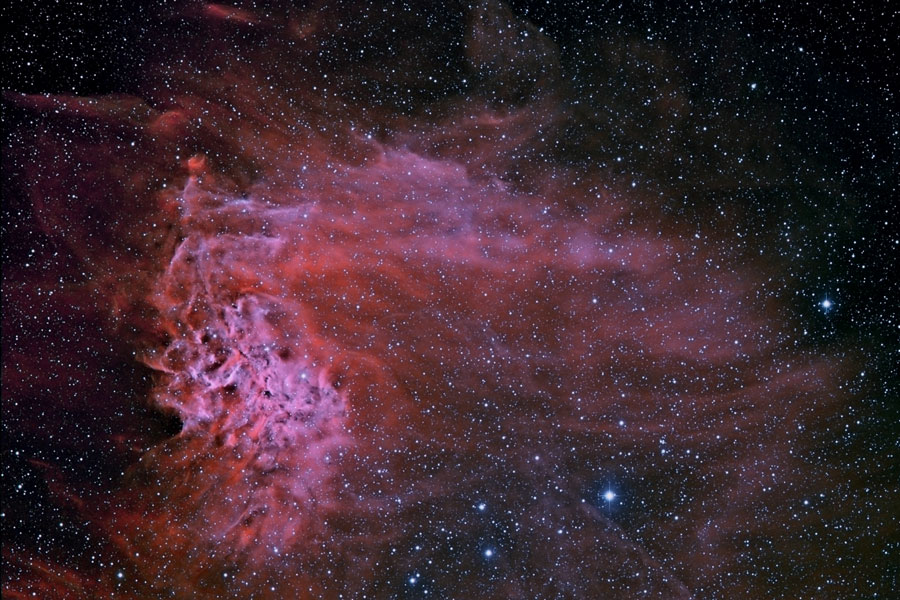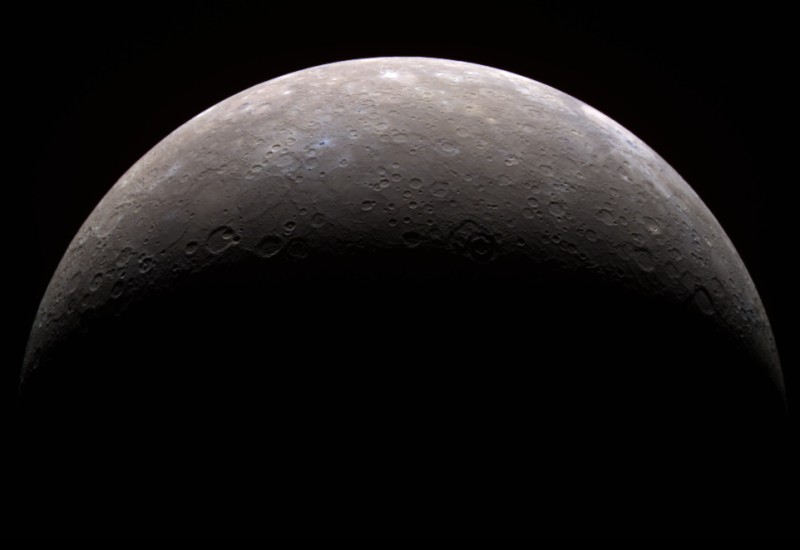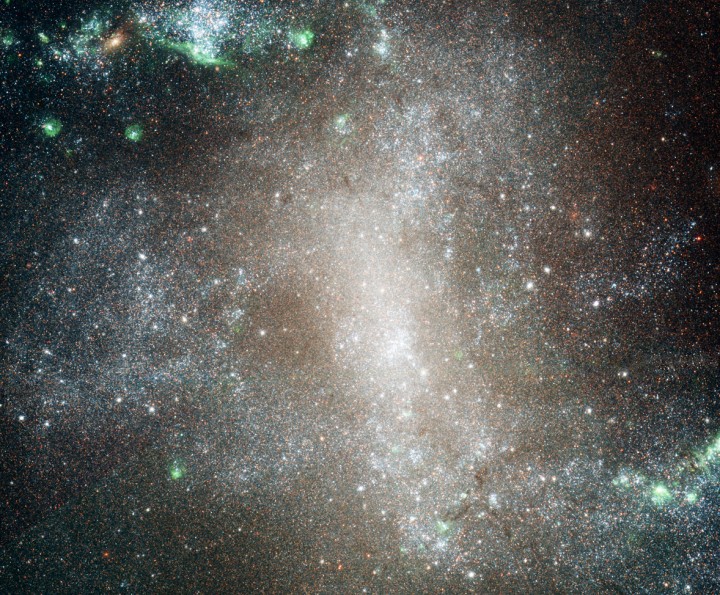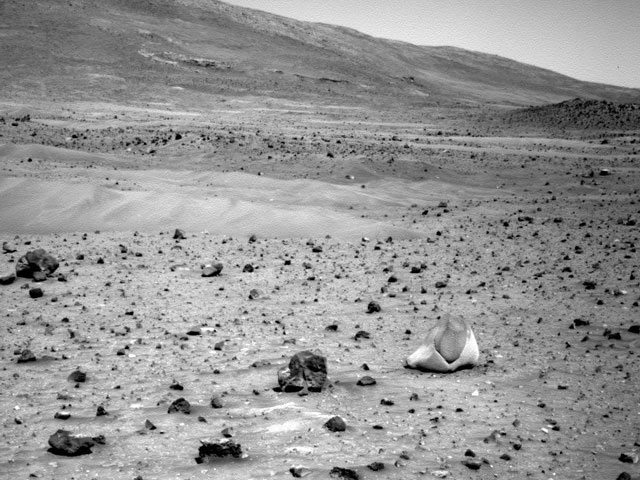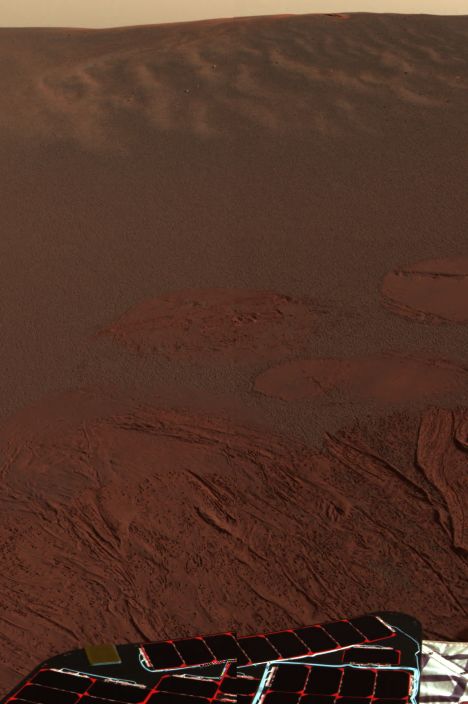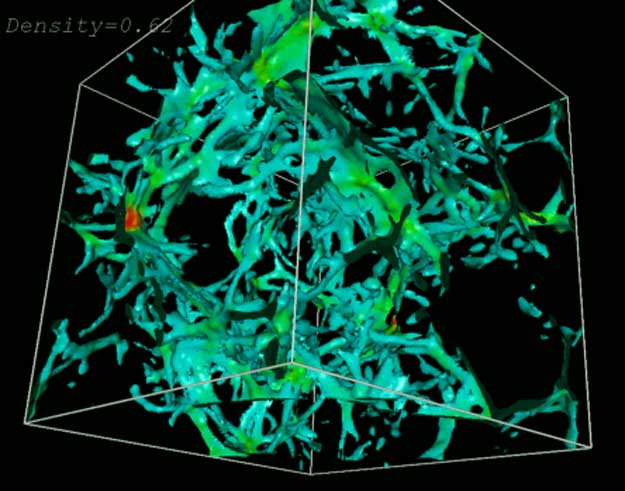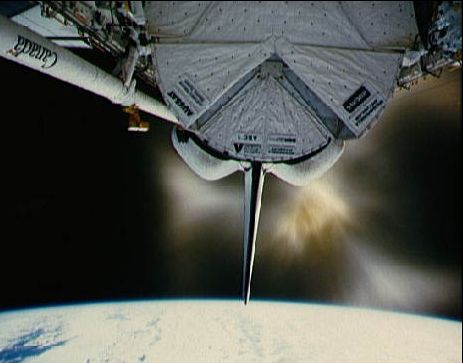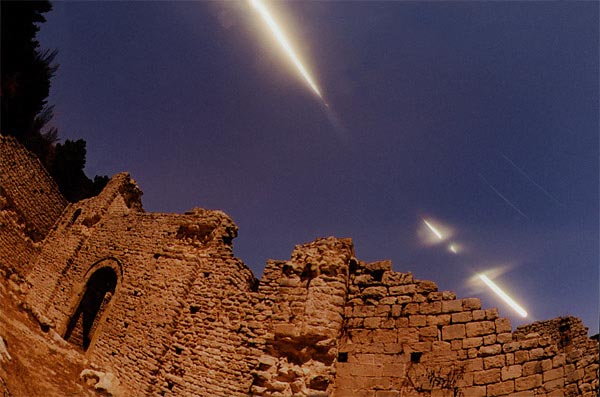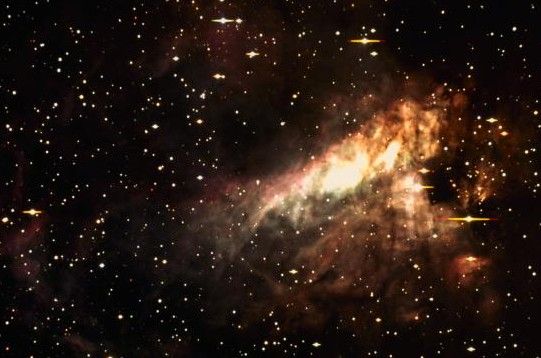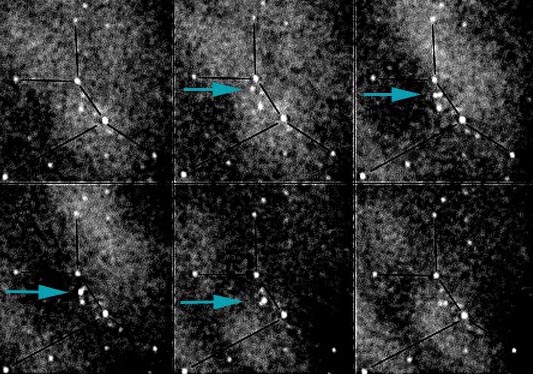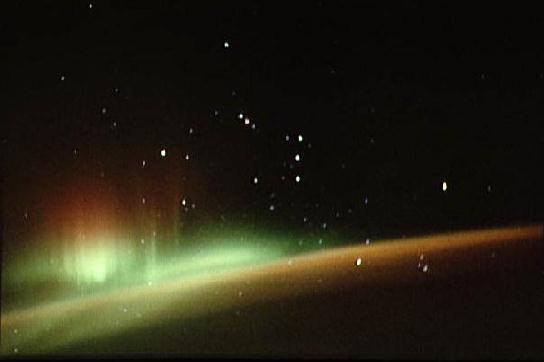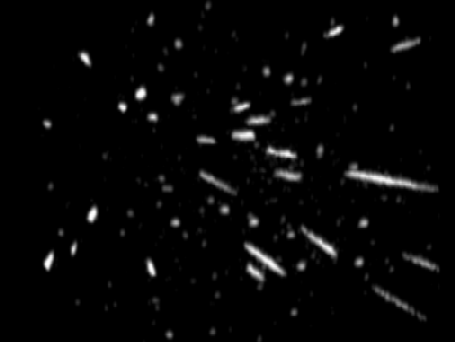| << Previous | Index | Next >> |
2015 You may have heard of the Seven Sisters in the sky, but have you heard about the Seven Strong Men on the ground? Located just west of the Ural Mountains, the unusual Manpupuner rock formations are one of the Seven Wonders of Russia. How these ancient 40-meter high pillars formed is yet unknown. The persistent photographer of this featured image battled rough terrain and uncooperative weather to capture these rugged stone towers in winter at night, being finally successful in February of last year. Utilizing the camera's time delay feature, the photographer holds a flashlight in the foreground near one of the snow-covered pillars. High above, millions of stars shine down, while the band of our Milky Way Galaxy crosses diagonally down from the upper left.
2014 It was a quiet day on the Sun. The above image shows, however, that even during off days the Sun's surface is a busy place. Shown in ultraviolet light, the relatively cool dark regions have temperatures of thousands of degrees Celsius. Large sunspot group AR 9169 from the last solar cycle is visible as the bright area near the horizon. The bright glowing gas flowing around the sunspots has a temperature of over one million degrees Celsius. The reason for the high temperatures is unknown but thought to be related to the rapidly changing magnetic field loops that channel solar plasma. Large sunspot group AR 9169 moved across the Sun during 2000 September and decayed in a few weeks.
2013 Moonlight illuminates a snowy scene in this night land and skyscape made on January 17 from Lower Miller Creek, Alaska, USA. Overexposed near the mountainous western horizon is the first quarter Moon itself, surrounded by an icy halo and flanked left and right by moondogs. Sometimes called mock moons, a more scientific name for the luminous apparations is paraselenae (plural). Analogous to a sundog or parhelion, a paraselene is produced by moonlight refracted through thin, hexagonal, plate-shaped ice crystals in high cirrus clouds. As determined by the crystal geometry, paraselenae are seen at an angle of 22 degrees or more from the Moon. Compared to the bright lunar disk, paraselenae are faint and easier to spot when the Moon is low.
2012
[imghover6=http://apod.nasa.gov/apod/image/1201/sm ... gc4449.jpg]http://apod.nasa.gov/apod/image/1201/sm ... insert.jpg[/imghover6]Image Credit & Copyright: R Jay Gabany (Blackbird Obs.), Insert: Subaru/Suprime-Cam (NAOJ),
Collaboration: David Martinez-Delgado (MPIA, IAC), et al.
Collaboration: David Martinez-Delgado (MPIA, IAC), et al.
2011
[imghover6=http://apod.nasa.gov/apod/image/1101/m51ir_hubble.jpg]http://apod.nasa.gov/apod/image/1101/m51op_hubble.jpg[/imghover6]Credit: Infrared: NASA, ESA, M. Regan & B. Whitmore (STScI), & R. Chandar (U. Toledo);
Optical: NASA, ESA, S. Beckwith (STScI), & the Hubble Heritage Team (STScI/AURA)
Optical: NASA, ESA, S. Beckwith (STScI), & the Hubble Heritage Team (STScI/AURA)
2010 A hole crossed the Sun for a few minutes this month, as seen across a thin swath of planet Earth. The event on January 15 was actually an annular solar eclipse, and the hole was really Earth's Moon, an object whose dark half may appear even darker when compared to the tremendously bright Sun. The Moon was too far from Earth to create a total solar eclipse, but instead left well placed observers with a bright surrounding circle called the ring of fire. Pictured above was a complete solar annular eclipse sequence as seen above the Ananda Temple in Bagan, Myanmar. The image of the ancient temple, built around the year 1100, was taken after sunset on the same day of the eclipse. The next solar eclipse will be a total solar eclipse during 2010 July.
2009 Is star AE Aurigae on fire? No. Even though AE Aurigae is named the flaming star, the surrounding nebula IC 405 is named the Flaming Star Nebula, and the region appears to harbor red smoke, there is no fire. Fire, typically defined as the rapid molecular acquisition of oxygen, happens only when sufficient oxygen is present and is not important in such high-energy, low-oxygen environments such as stars. The material that appears as smoke is mostly interstellar hydrogen, but does contain smoke-like dark filaments of carbon-rich dust grains. The bright star AE Aurigae, visible near the nebula center, is so hot it is blue, emitting light so energetic it knocks electrons away from surrounding gas. When a proton recaptures an electron, red light is frequently emitted, as seen in the surrounding emission nebula. Pictured above, the Flaming Star nebula lies about 1,500 light years distant, spans about 5 light years, and is visible with a small telescope toward the constellation of the Charioteer (Auriga).
2008 Hard to spot against the twilight glow near planet Earth's horizon, a crescent Mercury was imaged close up by the MESSENGER spacecraft early last week. Colors in this remarkable picture were created using data recorded through infrared, red, and violet filters. The combination enhances color differences otherwise not visible to the eye across the innermost planet's cratered surface. In this view, light bluish material seems to surround relatively new craters, contrasting with the mostly drab, brown terrain. Mercury itself is 4,880 kilometers in diameter. The full resolution image shows features as small as 10 kilometers across.
2007 Like grains of sand on a cosmic beach, individual stars of barred spiral galaxy NGC 1313 are resolved in this sharp composite from the Hubble Space Telescope's Advanced Camera for Surveys (ACS). The inner region of the galaxy is pictured, spanning about 10,000 light-years. Hubble's unique ability to distinguish individual stars in the 14 million light-year distant galaxy has been used to unravel the fate of star clusters whose bright young stars are spread through the disk of the galaxy as the clusters dissolve. The exploration of stars and clusters in external galaxy NGC 1313 offers clues to star formation and star cluster evolution in our own Milky Way.
2006 How did this unusual Martian rock form? The atypical two-toned rock, visible in the lower right of the above image, was photographed a few days ago by the robotic Spirit rover currently rolling across Mars. For now, the environmental processes that created the rock remain a matter of speculation. Finding unusual rocks is not unusual for Spirit or its twin rover Opportunity, however. Over the past two years, for example, the rovers have unexpectedly discovered very small gray pebbles dubbed blueberries, and a rock out in the middle of nowhere now thought to be a meteorite. Having investigated alien terrain and having found clear evidence that part of Mars had a wet past, the Earth-launched Martian rovers are now entering their third spectacular year exploring the red planet.
2005 The new Delta IV Heavy Launch Vehicle is the largest rocket ever to be launched by the US Air Force. The Delta IV Heavy is capable of launching over 23,000 kilograms into low Earth orbit. The first launch of the Delta IV Heavy occurred last month and was largely successful with the exception that the boosters shut off several seconds prematurely. Boeing's Delta IV Heavy is the largest of the Delta IV series, packing the punch of three rocket boosters instead of one. Pictured above, the Delta IV Heavy is seen lifting off by a RocketCam perched on its side. The time-lapse sequence shows the launch, one of the rocket boosters being jettisoned, and a test satellite further lifting away. Lockheed Martin is developing its own heavy lifting version of its Altas rocket series in conjunction with the US Air Force's Evolved Expendable Launch Vehicle (EELV) progam.
2004 After an interplanetary journey of nearly 300 million miles, Opportunity bounced down on the martian surface at about 9:05 pm PST Saturday, its final plunge cushioned by airbags. Now the second NASA rover on Mars, Opportunity's landing site at Meridiani Planum is on the opposite side of the red planet from its twin rover Spirit. Described as unlike any ever seen on Mars, the dark, undulating terrain at Meridiani Planum (aka Terra Meridiani) is pictured above in the first stunning color view from Opportunity. This area is thought to be rich in gray hematite, an iron-bearing mineral which can form in watery environments. Part of the rover's deck is in the foreground while circular impressions and drag marks made by the airbags are visible just beyond it.
2003 We live in a forest. Strewn throughout the universe are "trees" of hydrogen gas that absorb light from distant objects. These gas clouds leave numerous absorption lines in a distant quasar's spectra, together called the Lyman-alpha forest. Distant quasars appear to be absorbed by many more Lyman-alpha clouds than nearby quasars, indicating a Lyman-alpha thicket early in our universe. The above image depicts one possible computer realization of how Lyman-alpha clouds were distributed at a redshift of 3. Each side of the box measures 30 million light-years across. Much remains unknown about the Lyman-alpha forest, including the real geometry and extent of the clouds, and why there are so many fewer clouds today.
2002 The Space Shuttle Discovery's orbital maneuvering system (OMS) engine firing produced this dramatic flare as it cruised "upside down" in low Earth orbit. Discovery was named for a ship commanded by Captain James Cook RN, the 18th Century English astronomer and navigator. Cook's voyages of discovery established new standards in scientific exploration and brought extensive knowledge of the Pacific regions, including Australia, New Zealand, and the Hawaiian Island archipelago to Europeans. The Space Shuttle Endeavor, also named after one of Cook's ships, is the newest of NASA's four-orbiter shuttle fleet.
2001 Well over a thousand galaxies are known members of the Virgo Cluster, the closest large cluster of galaxies to our own local group. The galaxy cluster is difficult to see all at once because it covers such a large area on the sky. Still, this excellent telescopic view records the region of the Virgo Cluster around its dominant giant elliptical galaxy M87. M87 can be seen as a fuzzy patch near the picture's bottom center. In fact, a close examination of the image will reveal that many of the "stars" are actually surrounded by a telltale fuzz, indicating that they are Virgo Cluster galaxies. How many galaxies can you pick out? Click on the image for an uncropped, labeled version which includes the NGC catalog numbers for most of the visible galaxies. On average, Virgo Cluster galaxies are measured to be about 48 million light-years away. The Virgo Cluster distance has been used to give an important determination of the Hubble Constant and the scale of the Universe.
2000 During last week's lunar eclipse, our Moon appeared to disappear. As the Earth moved between the Moon and the Sun, the Earth's shadow fell on the moon, making it quite dark. In the above photograph, the Earth's rotation caused the Moon and stars to appear as streaks during this four-hour exposure. In the foreground is the abbey of the Benedictive monastery of Sant Llorenc del Munt, a structure in Girona, Spain that has stood since the eleventh century. As the Earth's shadow engulfed the Moon, the Moon streak became less and less bright, practically disappearing during totality. At this time, the Moon, which normally shines by reflecting direct sunlight, shone only by sunlight refracted through the Earth's atmosphere. Later, clouds obscured the re-appearing Moon.
1999 The Omega Nebula contains glowing gas, dark dust, and some unusually massive stars. Also known as the M17 and the Swan Nebula, the Omega Nebula is about 5000 light-years away, 20 light-years across, and visible with binoculars in the constellation of Sagittarius. A recent epoch of star formation has created some very massive stars that haven't yet had time to self-destruct. Until then, these stars appear very bright and emit light so energetic it breaks up the surrounding gas and dust. The streaks across the bright stars are blemishes caused by the digital camera.
1998 Last Thursday an interplanetary spacecraft flew right past the Earth. The above images show sunlight momentarily reflected from this spacecraft's solar panels. No aliens were involved - the Near Earth Asteroid Rendezvous (NEAR) mission actually originated from Earth. Launched in 1996, NEAR zipped past the asteroid 253 Mathilde last June. This Earth flyby gravitationally deflects NEAR onto a trajectory passing the asteroid 433 Eros next year. Above, NEAR appears to move through the constellation of Perseus, as clouds created a changing diffuse white glow. NEAR was only visible for about 2 minutes from San Jose, California, where these image-intensified video camera observations were taken.
1997 Looking toward the south from low Earth orbit, the crew of the Space Shuttle Endeavor made this stunning time exposure of the Aurora Australis or southern lights in April of 1994. Aurora are visible at high northern latitudes as well, with the northern lights known as Aurora Borealis. They are caused by high energy electrons from the Solar Wind which are funneled into the atmosphere near the poles by the Earth's magnetic field. The reddish colors occur at the highest altitudes (about 200 miles) where the air is least dense. At lower altitudes and greater densities green tends to dominate ranging to a pinkish glow at the lowest. The familiar constellation of Orion the Hunter is clearly visible above the dark horizon in the background. Because of the shuttle's orbital motion, the bright stars in Orion appear slightly elongated.
1996 Meteor showers are caused by streams of solid particles, dust size and larger, moving as a group through space. In many cases, the orbits of these meteor streams can be identified with the dust tails of comets. When the Earth passes through the streams, the particles leave brilliant trails through the night sky as they burn up in the atmosphere. Above is an image of a meteor shower known as the Quadrantids. It was made in January 1995 using MOVIE, a new system for making video meteor observations. To make the image, frames from a video tape were computer processed and superposed to show the relative paths of many meteors in the shower. The meteor paths are all parallel to each other, but the effect of perspective causes the trails to appear to originate from a distant radiant point in the sky. In contrast to the elongated meteor trails, the brighter stars of the familiar constellation Ursa Major (the Big Dipper) are visible as points in the lower half of the image.
| << Previous | Index | Next >> |
